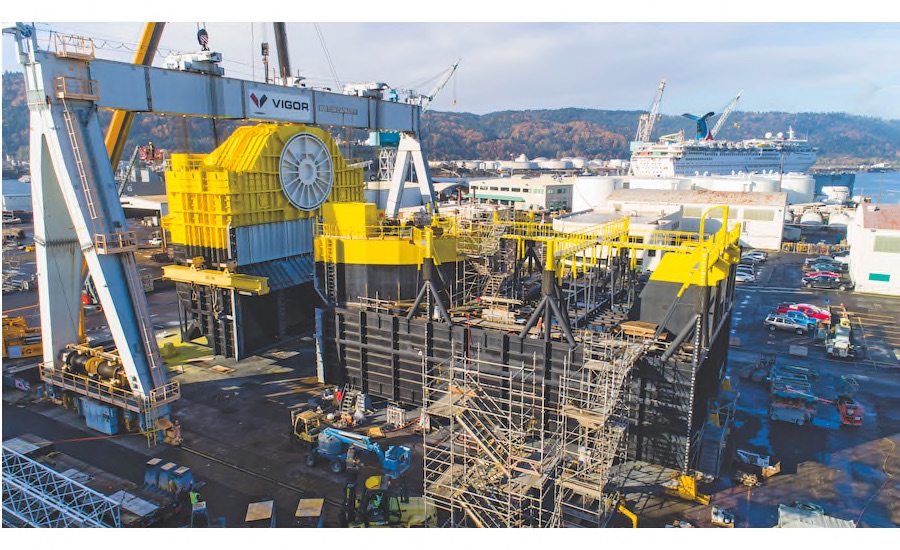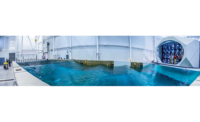Fabrication of a giant barge-like wave energy device is underway in Portland, Ore., in preparation for testing in Hawaii this summer.
The hull for the 125-ft-long by 59-ft-wide, 86-ton OE Buoy—with potential rated capacity of more than 1 MW in electrical power production—is complete. At Portland-based Vigor Marine, crews are assembling and fitting the device and installing the power take-off system, expected to take up to 10 weeks.
Once complete, the buoy will be towed from Portland to Hawaii for 12 months of testing beginning this summer at the U.S. Navy Wave Energy Test Site, says John McCarthy, chief executive officer at Ocean Energy, based in Ireland. The $12-million project will be connected to the grid at the Navy site, he says.
When seawater enters the submerged chambers of the buoy, it forces air through a turbine. As the water recedes, it creates a vacuum and the turbine continues to rotate in the same direction, creating electricity.
Two other wave power systems are scheduled to be tested this year at the Navy site. Columbia Power, soon to build a $3-million dataRay low-power device in Oregon, will test its $7 millionStingRAY utility-scale wave energy converter, and Oscilla Power plans to test its 100-KW Triton C, a full-scale multimode point absorber wave device. Oscilla is also developing a 30-ft by 20-ft utility-scale Triton wave energy converter that will be three times the size of the Triton C. Its investment in both projects is $20 million, says Tim Mundon, Oscilla Power chief engineer. The concept for Oscilla’s technology involves a float that moves vigorously in the waves below a ring-shaped float that resists its motion. “The relative motion of those two bodies is what generates power,” says Mundon.
Once construction is finished on the Triton C this fall, the device will be shipped to Hawaii, says Mundon. After testing, the team plans to deploy it offshore of a remote community in Washington state.
Testing the Triton C for a year in Hawaii waters is a step toward commercialization, says Mundon. “After we demonstrate that success, we would look to be selling devices based on that system ... taking the learning during deployment and evolving the system so it’s better.”
The Energy Dept. recently awarded $25 million to help further develop marine and hydrokinetic projects. “This is the best funding year ever,” says Tim Ramsey, DOE program manager for marine and hydrokinetic. “It’s been a few years since we’ve had big in-water tests. We’re very excited.”
Six ocean energy converters, two turbine designs and three control and power take-off systems are receiving awards from DOE, as well as a project that will help with permitting for a total of 12 projects. The DOE estimates there are 25 tidal ocean energy and 50 wave energy companies in the U.S. The latest DOE nationwide assessments identify up to 1,400 terawatt-hours of potential wave and tidal generation per year. One terawatt-hour of electricity is enough to power 85,000 homes.
“Many developers are now exploring smaller-scale solutions individually tailored to particular site conditions or local grid constraints,” says Ramsey, “and there is a growing realization that there is no one size fits all in terms of harnessing the ocean’s power.”
Despite years of research and tests, there are no commercial deployments in the U.S. of marine hydrokinetic systems. The marine environment makes deploying a system more difficult and expensive. Still, if successful, wave and other hydrokinetic energy could have advantages over other forms of renewable power such as wind or solar.
“For ocean wave power, there are benefits in terms of energy density, variability, forecastability and location relative to urban centers,” said Ted Brekken, an energy systems professor at Oregon State University, in an email exchange. “The energy in waves is very dense (for example, 30 kW per meter). It also doesn’t change much from minute to minute, thus having low variability. And the wave climate can be forecasted pretty well up to a few days in advance.” Such power is also close to population centers, and tidal power has the advantage of accuracy in forecasts, he added.





Post a comment to this article
Report Abusive Comment